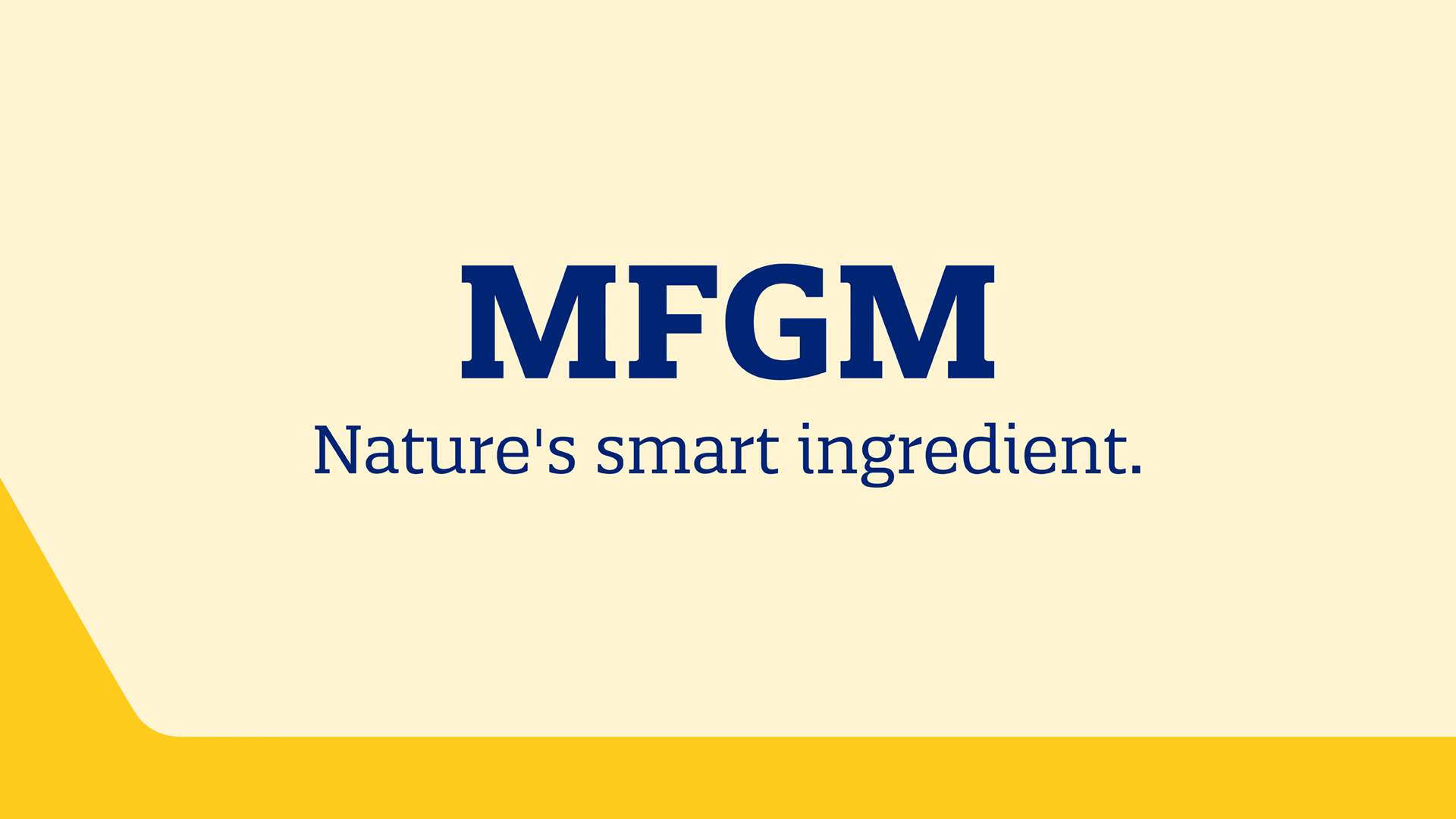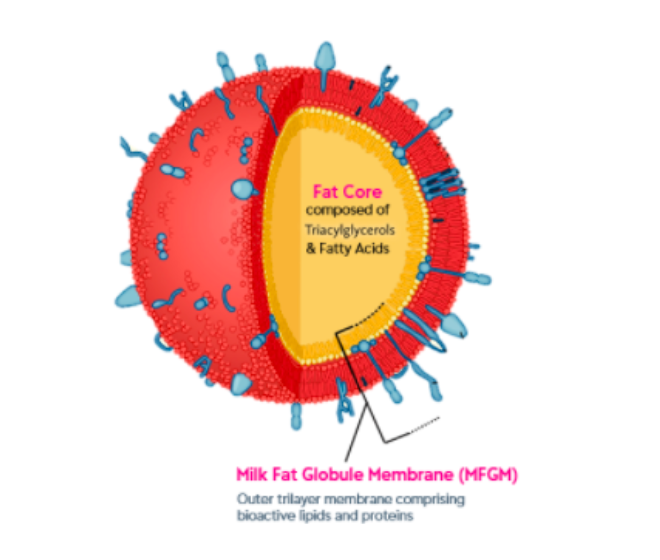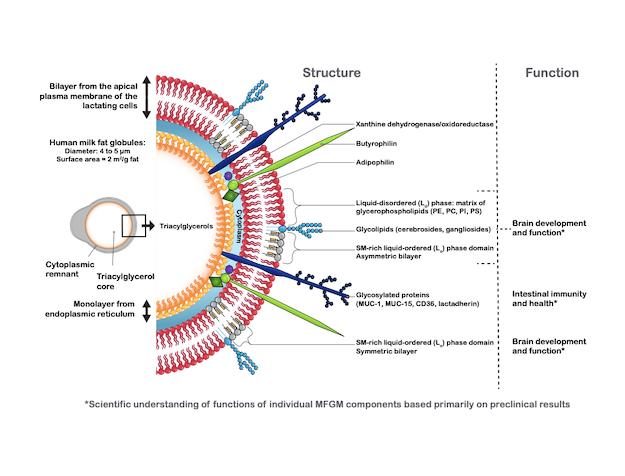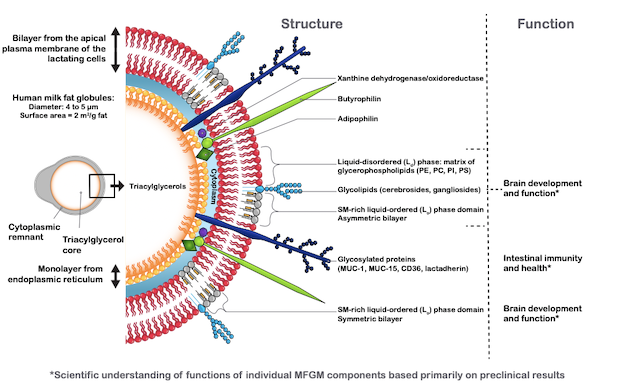Key Points
-
Mammalian milk fats comprise triglycerols, fatty acids and complex lipids
-
Milk fat globule comprises a fat core surrounded by a milk fat globule membrane
-
MFGM lipid components support brain development and functions
-
MFGM protein components support immune and gut functions
Compositionally, mammalian milk fats comprise 3 broad components, namely triacylglycerols, fatty acids and complex lipids.1
Triacylglycerols, complex lipids and fatty acids broadly form the 3 types of mammalian milk fats.
Triacylglycerols form the bulk, accounting for 98-99%, of milk fats.They are a key source of energy.
Complex lipids include phospholipids, sphingolipids, glycosylceramides and sterol lipids. Phospholipids include phosphatidylcholine (PC), phosphatidylethanolamine (PE), phosphatidylserine (PS) and phosphatidylinositol (PI). Sphingolipids include sphingomyelin (SM) and gangliosides. SM is often considered both a phospholipid and a sphingolipid.
Phospholipids and sphingolipids play central roles in cerebral neurogenesis and migration during fetal development, as well as promoting neuronal growth, differentiation, and synaptogenesis during the first year of life. PS, PI and gangliosides play functional roles within the body, including the support of gut, immune, and brain development.1
Structurally, milk fat globule comprises a fat core surrounded by a milk fat globule membrane.2,3,4
The fat core within MFGM contains mainly the triacylglycerols, a key source of energy, and traces of fatty acids.2,3,4
Surrounding the fat core is the MFGM, a complex and unique trilayer composed primarily of bioactive lipids and proteins. The trilayer is made up of an inner monolayer originated from the endoplasmic reticulum within the mammary lactating cells and an outer bilayer originated from the plasma membrane of the mammary lactating cells.2,3,4
MFGM composition varies considerably among individuals and over the course of lactation. The variations may be due to maternal factors such as diet, environment, maternal genetics and body composition, as well as the changing needs of the infant over the period of lactation.2,3,4
MFGM functions as an emulsion to stabilize the globule between the triacylglycerol core and water.2,3,4
MFGM is not absorbed intact by the intestinal epithelium. Before absorption by intestinal epithelium, MFGM components are broken down by digestive enzymes. Some of these broken down MFGM components form part of the plasma membrane of the intestinal epithelium. Others get absorbed by the intestinal epithelium and reassembled before entering into circulation.2,3,4
MFGM lipid components support brain development and functions.3,4
The lipid fraction of MFGM is rich in phospholipids, sphingolipids, and cholesterol. Phospholipids include sphingomyelin (SM), phosphatidylcholine (PC), and phosphatidylethanolamine (PE), phosphatidylserine (PS) and phosphatidylinositol (PI). Sphingolipids include sphingomyelin (SM) and gangliosides. SM is often considered a phospholipid and a sphingolipid.3,4
Phospholipids make up approximately 30% of the total lipid weight of MFGM, the three most prominent being SM, PC and PE, which together represent up to 85% of total phospholipids. PS and PI are relatively minor components.3,4
Lipid Components of Milk Fat Globule Membrane
| COMPONENTS | BIOLOGICAL SIGNIFICANCE | PHOSPHOLIPIDS (PL) |
|---|---|---|
| Phosphatidylinositol (PI) | 4.6 % of total PL | Cell signalling; activation of Akt |
| Phosphatidylcholine (PC) | 25.2 % of total PL | Membrane structure; lipoprotein assembly and secretion |
| Phosphatidylseine (PS) | 5.9 % of total PL | Induction of apoptosis; carrier of DHA |
| Phosphatidylethanolamine | 28.6% of total PL | Component of phospholipase D; cell proliferation and differentiation by regulation of pathways including MAPK and NF-kB |
| Sphingomyelin (SM) | 35.7 % of total PL | Metabolised to ceramide and sphingosine; vascular development; immune function |
| Gangliosides | 14.8-26.8 mg/L in human milk | Cognitive development; altering membrane fluidity and function of enterocytes; cell-cell communication; gut maturation and immunity |
| Cholesterol | 90-150 mg/L in human milk | Structural maintenance of membranes; compartmentalisation of membrane protein to modulate function; substrate for bile acids, vitamin D, hormones and oxysterols |
Sphingomyelin (SM) is a key component of the myelin sheath, which insulates axons and supports efficient transmission of nerve impulses. SM and other sphingolipids are also present in the gut epithelium, where they contribute to membrane structure, modulate growth factor receptors, and provide binding sites for microorganisms, microbial toxins, and viruses. Furthermore, SM and its metabolites (ceramide, sphingosine, ceramide-1-P, and sphingosine-1-P) act as second messengers in cell signaling, with regulatory effects on cell proliferation, cell survival, apoptosis, and inflammation.3,4
Phosphatidylcholine (PC) is a major structural component of biological cell membranes and a major source of choline. It is involved in the synthesis of SM as well as regeneration of choline and its metabolites, which include the neurotransmitter acetylcholine. In addition to its membrane effects, PC is a key constituent of the intestinal mucus barrier.3,4
Phosphatidylserine (PS) is most concentrated in the brain despite being present throughout the human body. It serves a variety of structural and regulatory functions, including contribution to membrane fluidity and therefore the regulation of biological cell activities. It also supports signal transduction by activating cell surface receptors that react to chemical stimuli, and facilitates membrane-to-membrane fusion, which is a central process in the release of neurotransmitters such as acetylcholine, dopamine, serotonin, and norepinephrine.3,4
Gangliosides are important structural components within the cellular membranes of most body tissues, including nuclear, endoplasmic reticulum, and plasma membranes. Gangliosides are enriched at the synaptic membrane of neurons, and are functionally involved in neurotransmission and synapse formation. Brain ganglioside accretion occurs at an accelerated rate in the early years of life, coinciding with the most active period of myelination, axonal outgrowth, and synaptogenesis.3,4
Outside of the central nervous system, ganglioside may possibly contribute to improved gut microflora and antibacterial defense. It also appears to play a role in cell-cell recognition and adhesion, as well as signal transduction within cell surface microdomains, alongside other sphingolipid components and cholesterol.3,4
MFGM protein components support immune and gut functions.3,4
The protein components of MFGM comprise a number of glycosylated and non-glycosylated proteins, in the outer layer of MFGM. There are at least 191 different known proteins in human MFGM, and comparable numbers in bovine milk protein concentrates. These only represent 1% to 2% of total milk protein content3,4
MFGM proteins are known to have bioactive and potentially health-benefiting properties. Almost half of the identified proteins have cell signaling functions. Mucins (MUC-1, MUC-4, MUC-15), butyrophilin, lactadherin, and CD36 have been suggested to enhance triglyceride digestion efficiency. Lactadherin, MUC-1 and xanthine oxidase have been suggested in preclinical studies to possess antimicrobial properties.3,4
| Protein | Molecular Weight(kDa) | Function | |
|---|---|---|---|
| Major Human MFGM Proteins | Butyrophilin subfamily 1 member A1 *BTN1A1 | 56 | Milk fat globule secretion, immune system |
| Mucin 1 (MUC 1/PAS 0) | 250-450 | Immune protection | |
| Mucin 4 (MUC 4) | 232 | Immune protection | |
| Xanthine oxidase (XDH/XO,XOR) | 145 | Milk fat globule secretion, immune system | |
| Lactadherin (PAS VI/VII, MFG-EB) | 43 | Immune protection | |
| Cluster of differentiation 14 (CD14) | 40 | Immune protection | |
| Adipophilin (ADPH) | 52 | Milk fat globule secretion | |
| Fatty-acid binding protein (FABP) | 13 | Fatty acid transport, Milk fat globule lipid synthesis | |
| Minor Human MFGM Proteins | Carbonic anhydrase 6 | 35 | Acid neutralizer, antibacterial components and growth factor |
| Milk alkaline phosphatase (AP) | 86 | Immune system | |
| Lysozyme | 17 | Antibacterial component, immune system | |
| Lactoferrin | 78 | Antibacterial component, immune system | |
| Osteopontin | 41-75 | Antibacterial component, immune system | |
| A-Lactalbumin | 16 | Antibacterial component, immune system | |
| Immunoglobulins (e.g, loa a-chain C region) | 37-38 | Antibacterial component, immune system | |
| Toll-like receptors (eg, TLR2, 4) | 90 | Antibacterial component, immune system | |
| Clustering | 52 | Antibacterial component | |
| Tenascin | 241 | Antibacterial component |
References
- Wei W, Jin Q, Wang X. Human milk fat substitutes: Past achievements and current trends. Prog Lipid Res. 2019;74:69-86.
- Lopez C, Ménard O. Human milk fat globules: polar lipid composition and in situ structural investigations revealing the heterogeneous distribution of proteins and the lateral segregation of sphingomyelin in the biological membrane. Colloids Surf B Biointerfaces. 2011 Mar;83(1):29-41.
- Brink LR, Lönnerdal B. Milk fat globule membrane: the role of its various components in infant health and development. J Nutr Biochem. 2020 Nov;85:108465.
- Lee H, Padhi E, Hasegawa Y, et al. Compositional Dynamics of the Milk Fat Globule and Its Role in Infant Development. Front Pediatr. 2018;6:313.
- Wei W, Jin Q, Wang X. Human milk fat substitutes: Past achievements and current trends. Prog Lipid Res. 2019;74:69-86.
- Lopez C, Ménard O. Human milk fat globules: polar lipid composition and in situ structural investigations revealing the heterogeneous distribution of proteins and the lateral segregation of sphingomyelin in the biological membrane. Colloids Surf B Biointerfaces. 2011 Mar;83(1):29-41.
- Brink LR, Lönnerdal B. Milk fat globule membrane: the role of its various components in infant health and development. J Nutr Biochem. 2020 Nov;85:108465.
- Lee H, Padhi E, Hasegawa Y, et al. Compositional Dynamics of the Milk Fat Globule and Its Role in Infant Development. Front Pediatr. 2018;6:313.








